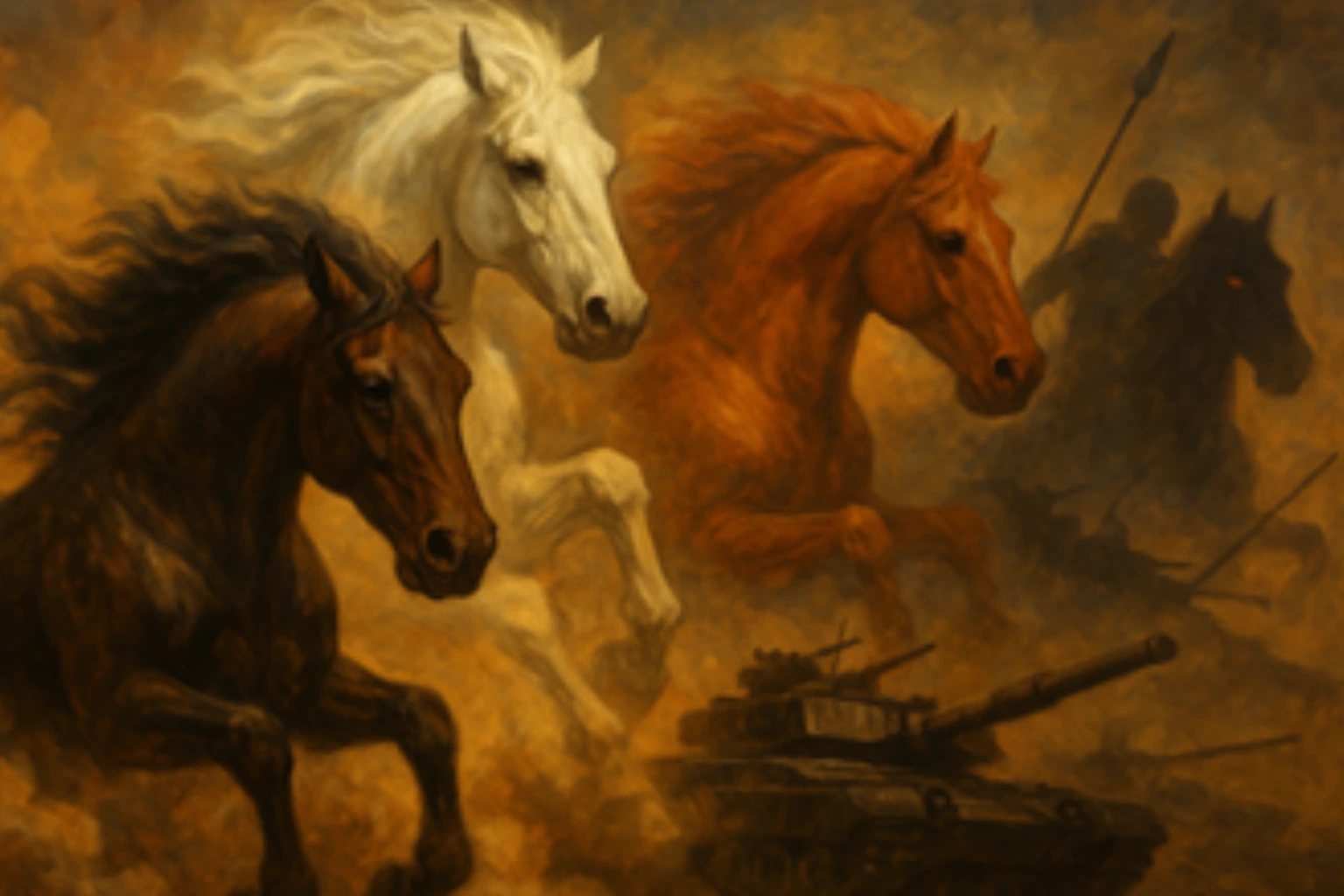Horses in prophecy – animal or image?
27-10-2025 - Posted by Geert-JanOriginally posted on October 26, 2025 – by Andre Piet
In various prophecies about the end time, mention is made of horses. This raises the question of how this should be understood. Is it about literal animals that will play a role in future wars? Or is the language meant symbolically? Especially in our time, in which warfare no longer takes place on horseback, that seems strange at first glance. And yet, horses are explicitly mentioned in Scripture in prophecies that are still future (such as Zechariah 12:4; Ezekiel 38:4; Micah 5:10). How are we to understand this?
symbolic language in Revelation
First this: sometimes the use of symbolic language is unmistakable. In Revelation 6, John reads about a red horse, a black horse, and a green (pale) horse. Such descriptions do not refer to literal animals but to powers that represent war, famine, or death. Even more clearly, Revelation 9 describes creatures that resemble horses, but have faces like humans, hair like women, and teeth like lions. These are not earthly animals, but apocalyptic symbols of judgment.
Revelation 19 is also unmistakably figurative: the return of Christ is described as a rider on a white horse, whose cloak has been dipped in blood, with many diadems on His head and a sword coming out of His mouth. No one reads this literally. The white horse is the symbol of His royal power with which He appears as Conqueror, followed by heavenly armies – likewise depicted on white horses.
These passages show that the term “horse” in prophetic language carries a deeper meaning than merely that of an animal.
prophecies with concrete language
There are, however, also prophecies that still await fulfillment and in which the language appears concrete and literal. Thus JAHWEH says in Zechariah 12:4:
In that day I will smite every horse with confusion, and its rider with madness…
Also in Ezekiel’s prophecies about Gog from the land of Magog (Ezekiel 38:4), horses, riders, and a great army are mentioned. And even in the future it is promised that God “will cut off your horses from your midst” (Micah 5:10). How do these concrete descriptions relate to the symbolic passages in Revelation?
The answer is not to replace the word “horse” with a modern military vehicle, but to understand what the horse represents in Scripture.
the horse as a symbol of military power
In the Bible, the horse does not stand for agriculture or civilian transport, but almost always for warfare. It was the means by which kings expanded their military power. That’s why we read in Deuteronomy 17:16:
Yet he (the king) must not increase horses for himself…so that he should not turn the people back to Egypt in order to increase horses.
Gathering horses meant building military strength. Psalm 20:8 also makes this clear:
These trust in chariots, and these in horses,
Yet we shall remember the Name of YHWH, our Elohim.
Horse and chariot here stand as representatives of human military force, in contrast to trust in God (cf. Psalm 147:10).
In prophetic language, “horse” is therefore often used as a designation for the military power of the nations. The word is correctly translated – it means horse – but it signifies more than the animal: it represents fighting strength.
recognizable in our own language
This symbolism also lives on in our modern language. We still speak of horsepower as a unit of engine power. The animal itself has disappeared from traffic, but the word has remained as an indication of strength.
Even more striking is the term cavalry. This word is directly derived from the Latin caballus (horse). Originally it meant: soldiers on horseback. Today, “cavalry” is used for tank divisions and armored vehicles. The term no longer refers to the animal, but to the function: a fast, mobile strike force.
This shows that the concept of the horse (even apart from the animal itself) remains intrinsically connected to military power. And that is precisely how it functions in Scripture.
conclusion: imagery with prophetic impact
When prophecies speak of horses in the events of the end time, the primary question is not whether literal horses will appear, but what these horses represent: the military power of the nations. The language is concrete, but the image is timeless. The horse then stood for military might – and it still does today, though in a different form.
The prophecies show that the nations will advance with their full military capacity against Jerusalem. But it is JAHWEH who will break their strength. Whether that strength manifests in horses, tanks, or drones – the terminology remains the same. The “horse” stands for the human force of arms which God will nullify in order to glorify His Name in Jerusalem.

 English Blog
English Blog